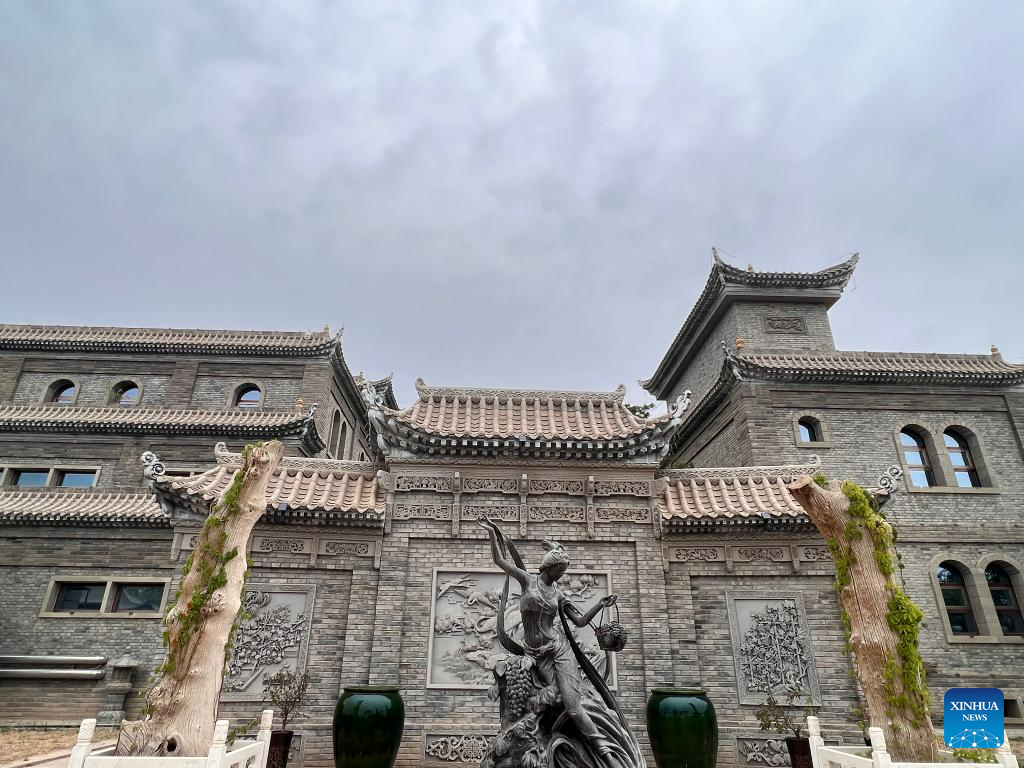Across China: Northwest China markets wine with classy Chinese culture
 0 Comment(s)
0 Comment(s) Print
Print E-mail Xinhua, June 07, 2023
E-mail Xinhua, June 07, 2023

This undated aerial photo shows Xige winery, whose design is inspired by ancient Chinese philosophy of "being round outside and square inside", in Qingtongxia City, northwest China's Ningxia Hui Autonomous Region. (Xinhua)
YINCHUAN, June 6 (Xinhua) -- For many alcohol connoisseurs from China, the terms "wine" (putaojiu in Chinese) and "winery" (jiuzhuang) often evoke European associations of romance and nobility, a stereotype winemakers have long endorsed to attract the country's middle-and-upper-class consumers.
But in one wine-producing area in northwest China's Ningxia Hui Autonomous Region, wineries are using the traditional Chinese culture to render a different taste to the stories behind their brands.
Wine bottles with ancient Chinese paintings, racks named after the Chinese 24 solar terms, and traditional Chinese-style architecture ... such are the common features of many wineries lying in the eastern foothill of Helan Mountain.
"The first time I visited the wineries in Ningxia, I was surprised to see so many traditional Chinese cultural elements in their buildings. It's really good indeed," said Maria Teresa Romero Ponce, a Chilean winemaker working in the Moon &Stone Winery in Ningxia.
Ningxia boasts a unique terroir in making top-class wine, with its prolonged sunshine and a cool, dry climate contributing to grape planting. Since the production of its first bottle of wine in 1984, the land-locked region has become a rising star on the world's wine map, with local wine winning several top international awards.
While wine brewing had been introduced into China as early as the Han Dynasty (202 BC - 220 AD), the modern Chinese wine industry has long been modeled on its European peers and used the wine's European pedigree as a marketing strategy.
"Ningxia has been learning from Europe especially France and used to bid itself as 'China's Bordeaux'," said Zhang Junxiang, professor with the Ningxia University.
"But now we are trying to develop our own characteristics, and local winemakers declare they come from China's Helan Mountain," said the long-time observer of China's wine industry.
The Chateau Lansai has been a pioneer in making local wine appear more Chinese.
After a wine-tasting tour around Europe in 2013, the winery's owners demolished their European-style winery buildings, which were still under construction, and opted for a Chinese design.
"The chateaus we visited were in similar European styles. Then we began to think, why can't we construct a Chinese style winery and brew wine with Chinese characteristics?" said Yu Xiaojia, one of the winery owners.
Upon entering the Chateau Lansai, visitors are greeted by a Chinese-style spirit screen, two old trees, and a stone statue of the grape goddess similar to the Flying Apsaras of the Mogao Grottoes.
Chinese symbols such as zodiac animals are commonplace in the winery, which has two Shanxi-style buildings and a delicate garden complete with a pond, streams, a pavilion, a bridge and sight-seeing terraces.
"We often receive international friends, and they are quite interested in the cultural elements of our winery. Some even wore traditional Chinese outfits during their second visit," said Yu.
Guests are also invited to taste the wine while sitting cross-legged on the heatable brick bed, just like dining with an ordinary rural family in north China.
"We try to break the stereotype that wine is limited to formal occasions. It is a drink that brings mirth and can blend into various scenarios of the Chinese lifestyle," she said.
Christelle Chene, the international affairs director of Xi'ge Winery, observes that the traditional Chinese culture has played an important role in Ningxia's wine promotion both domestically and internationally.
With a bottle of wine in her hand, Chene told customers the brand label is inspired by a painting of peach and turtledove drawn by a Chinese emperor in Song Dynasty, and that the wine's unique herbal flavor is from the special native variety of grape named Shelongzhu.
"Many customers are curious about the Chinese elements of our brand stories," she said. "Traditional Chinese culture is attractive. It makes our products more impressive and charming." ■

This photo taken with a mobile phone on June 4, 2023 shows a view of the winery building of the Chateau Lansai in Yinchuan, northwest China's Ningxia Hui Autonomous Region. (Xinhua/Ma Sijia)


